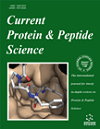- Home
- A-Z Publications
- Current Protein and Peptide Science
- Previous Issues
- Volume 23, Issue 11, 2022
Current Protein and Peptide Science - Volume 23, Issue 11, 2022
Volume 23, Issue 11, 2022
-
-
Emerging Hop Japanese Pollinosis in Asia
More LessAuthors: Chang-Gyu Jung and Hae-Sim ParkHop Japanese (Hop J) pollen has been considered one of the major causative pollen allergens in Far East Asia in the autumn season. The sensitization rate, pollen count, and allergenicity of Hop J pollens are increasing in this region because of increased air pollution and global warming. However, commercial skin test agents for the diagnosis and allergen extracts for the allergen immunotherapy are not availabl Read More
-
-
-
Oak Pollen Allergy in Korea
More LessAuthors: Kyoung Y. Jeong and Jung-Won ParkOak pollen allergy is common all over the world and an important cause of pollinosis. The molecular properties of some component allergens have been clearly characterized, while some of them are still waiting for characterization. Studies on some oak component allergens are neglected, possibly because of its high cross-reactivity to birch. However, the utilization of culprit allergen molecules is expected to increase the dia Read More
-
-
-
Birch Pollen Allergens
More LessAuthors: Lisha Li, Christopher Chang and Kai GuanBirch belongs to the order Fagales and the family Betulaceae. Birch pollen is one of the most important airborne inhaled allergens in the north temperate zone, leading to allergic rhinitis, asthma and pollen-related food allergy. The sensitization rate to birch pollen is about 8-16% in the general population and 7-57% in patients seen at various allergy centers. Seven birch pollen allergens have been recognized by the Inte Read More
-
-
-
A Comprehensive Comparative Review of Protein Sequence-Based Computational Prediction Models of Lysine Succinylation Sites
More LessLysine succinylation is a post-translational modification (PTM) of protein in which a succinyl group (-CO-CH2-CH2-CO2H) is added to a lysine residue of protein that reverses lysine's positive charge to a negative charge and leads to the significant changes in protein structure and function. It occurs on a wide range of proteins and plays an important role in various cellular and biological processes in both eukaryotes and prokaryotes. Read More
-
-
-
Apolipoprotein-mimetic Peptides: Current and Future Prospectives
More LessAuthors: Sunil A. Nankar, Sakeel Ahmed, Shyam S. Sharma and Abhay H. PandeApolipoprotein-mimetic peptides, mimicking the biological properties of apolipoproteins, have shown beneficial properties against various diseases (central and peripheral diseases) and have emerged as potential candidates for their treatments. Progress has been made from first-generation to second-generation apolipoprotein-mimetic peptides. Understanding these peptides from the first generation to the second generation is Read More
-
-
-
Glycation of Immunoglobulin-G from Pentose Sugar: A Cause for Structural Perturbations
More LessBackground: Glycation of immunoglobulin-G (IgG) molecules with monosaccharides may cause significant structural disability, thus resulting in their loss of function. The accumulation of AGEs formed from glycation plays an important role in the aliments associated with metabolic diseases. Therefore, excess sugar in plasma interferes with the functioning of IgG and may contribute to a wide range of diabetes-associated com Read More
-
-
-
Re-Analysis of Published Datasets in Search of Novel Urogenital Diseases Biomarkers
More LessAuthors: Luís Perpétuo, Visith Thongboonkerd, Rita Ferreira, Sofia Guedes, Francisco Amado and Rui VitorinoBackground: Exosome research is a current trend in functional proteomics as it provides important data on the pathophysiology and pathogenesis of diseases. The scientific outputs regarding these topics often only approach disease-protein/peptide/exosome or mechanismprotein/ peptide/exosome association. Approaching all three aspects could be the key to a better understanding of the pathophysiology and unco Read More
-
-
-
Dysregulation of SNHG16(lncRNA)-Hsa-Let-7b-5p(miRNA)-TUBB4A (mRNA) Pathway Fuels Progression of Skin Cutaneous Melanoma
More LessAuthors: Guanghua Chen and Jia YanObjective: Skin cutaneous melanoma(SKCM) is the most severe, and complex disease of all skin cancers. The molecular mechanisms of this cancer progression are not well understood. Methods: GEPIA online database was used to validate the differentially expressed genes from two GEO datasets. The prognostic value was calculated by the Kaplan-Meier method. RT-qPCR verified the expression of TUBB4A in SKCM cell line Read More
-
Volumes & issues
-
Volume 26 (2025)
-
Volume 25 (2024)
-
Volume 24 (2023)
-
Volume 23 (2022)
-
Volume 22 (2021)
-
Volume 21 (2020)
-
Volume 20 (2019)
-
Volume 19 (2018)
-
Volume 18 (2017)
-
Volume 17 (2016)
-
Volume 16 (2015)
-
Volume 15 (2014)
-
Volume 14 (2013)
-
Volume 13 (2012)
-
Volume 12 (2011)
-
Volume 11 (2010)
-
Volume 10 (2009)
-
Volume 9 (2008)
-
Volume 8 (2007)
-
Volume 7 (2006)
-
Volume 6 (2005)
-
Volume 5 (2004)
-
Volume 4 (2003)
-
Volume 3 (2002)
-
Volume 2 (2001)
-
Volume 1 (2000)
Most Read This Month
Article
content/journals/cpps
Journal
10
5
false
en


